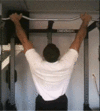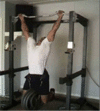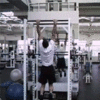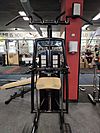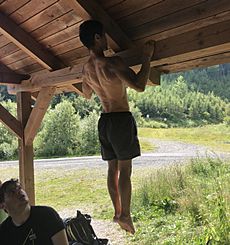Pull-up (exercise) facts for kids
A pull-up is a great exercise for building upper body strength! It's when you hang from a bar with your hands and pull your body up until your chin is above the bar. This exercise works many muscles in your upper body, especially your back muscles (like the latissimus dorsi), shoulder muscles (trapezius), and arm muscles (biceps brachii).
You can do pull-ups with different hand positions:
- Overhand grip (palms facing away from you)
- Underhand grip (palms facing towards you), which is sometimes called a chin-up
- Neutral grip (palms facing each other)
Pull-ups are often used in fitness tests and are a good way to train for many sports.
Contents
How to Do a Pull-Up
To do a pull-up, you start by hanging from a bar with your arms straight. Then, you pull your body upwards. Imagine trying to bring your chest towards the bar. Once your chin is above the bar, you slowly lower yourself back down until your arms are fully straight again.
Many muscles work together during a pull-up. At the start, muscles in your shoulders and upper back get active. As you pull up, your main back muscles (latissimus dorsi) and biceps (the muscles on the front of your upper arm) do most of the work. At the very top, other shoulder and arm muscles help you finish the movement.
It's important to use good form to keep your shoulders healthy. Some studies suggest that using an overhand grip with your hands about shoulder-width apart might be gentler on your shoulders.
Different Kinds of Pull-Ups
Pull-ups can be done in many ways, by changing your grip or adding challenges. Your hand position can be overhand (palms away), underhand (palms towards you, like a chin-up), or neutral (palms facing each other). Most people choose a grip that's a bit wider than their shoulders. Using a grip that's too wide can make the exercise harder and might even increase the risk of injury.
Equipment for Pull-Ups
Most people do pull-ups on a metal bar. You can find bars mounted in doorways for home use, or at gyms and parks. Some people also use towels, rotating handles, or gymnastics rings for different challenges.
Why People Do Pull-Ups
Pull-ups are a great way to check how strong your upper body is. They show how much strength you have compared to your body weight. Many jobs, like firefighting, police work, and military roles, require good upper body strength, and pull-ups are often part of their fitness tests.
Pull-ups are also used to train for many sports that need strong pulling muscles. This includes rock climbing, gymnastics, rope climbing, rowing, and swimming.
Sometimes, in fitness tests, women might do a "flexed arm hang" instead of a pull-up. This is because it can be harder for some women to do a full pull-up without specific training. However, studies show that with a good strength training program, many women can learn to do pull-ups!
Guinness World Records
Did you know there are world records for pull-ups?
- The record for the most pull-ups done in a row is 651! This was set by Kenta Adachi from Japan in 2022. It took him 87 minutes!
- The record for the most weight added to a weighted pull-up is 104.55 kg (about 230 pounds)! David Marchante from Spain set this record in 2016.
See also
 In Spanish: Dominada para niños
In Spanish: Dominada para niños


